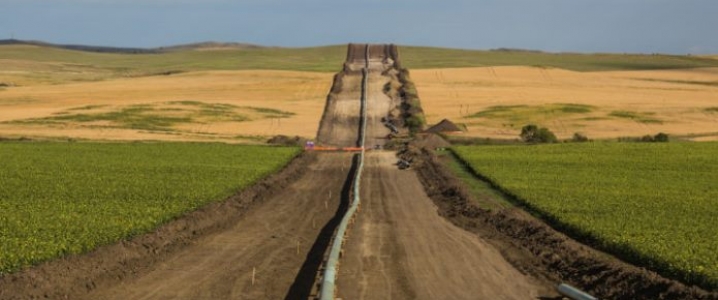Dakota Access Owners Evade Federal Regulators, Buy Land Surrounding Pipeline

Energy Transfer Partners—one of the major stakeholders in the controversial Dakota Access pipeline—bought over 6,000 acres of land surrounding the line’s route in North Dakota, according to several media reports over the weekend.
The deal includes lands that the Standing Rock Sioux Tribe says contains historical artifacts. Privately owned land does not fall under the jurisdiction of federal oil pipeline regulators, meaning that the agencies cannot block construction in the areas.
The North Dakota-based Forum News Service reported the sale on Friday.
A group of over 100 Native American Tribes and allied environmentalists have set up camp in and around the Standing Rock Sioux reservation neighboring the pipeline to protest its construction. The demonstrators argue the line would risk the pollution of the Missouri River and connected water sources and damage ancient tribal burial sites.
A deed filed in Morton County shows that David and Brenda Meyer sold 20 parcels of land, which contained more than 6000 acres, to Dakota Access last week at an undisclosed price, Forum said.
The Meyers signed two easements with Dakota Access LLC in February 2015 for the pipeline’s construction, according to The Bismarck Tribune.
David Meyer also holds a lease on grazing land that neighbors another plot of land currently being used as a camping ground for protestors. Both lands are owned by U.S. Army Corps of Engineers, which granted ETP permits to build Dakota Access.
Dakota Access’ builders now have ownership of some of the most controversial construction sites on the line’s route.
David and Brenda Meyer receive almost $600,000 worth of farm subsidies from the federal government, according to the Environmental Working Group’s Farm Subsidy Database.
The United States Department of Justice and other federal agencies delayed the line’s construction earlier this month in an ”unprecedented move” after a judge ruled against the Sioux tribe in a lawsuit that aimed to halt the project.
Related News
Related News

- Keystone Oil Pipeline Resumes Operations After Temporary Shutdown
- Biden Administration Buys Oil for Emergency Reserve Above Target Price
- Freeport LNG Plant Runs Near Zero Consumption for Fifth Day
- Enbridge to Invest $500 Million in Pipeline Assets, Including Expansion of 850-Mile Gray Oak Pipeline
- Williams Delays Louisiana Pipeline Project Amid Dispute with Competitor Energy Transfer
- Evacuation Technologies to Reduce Methane Releases During Pigging
- Editor’s Notebook: Nord Stream’s $20 Billion Question
- Enbridge Receives Approval to Begin Service on Louisiana Venice Gas Pipeline Project
- Mexico Seizes Air Liquide's Hydrogen Plant at Pemex Refinery
- Russian LNG Unfazed By U.S. Sanctions




Comments